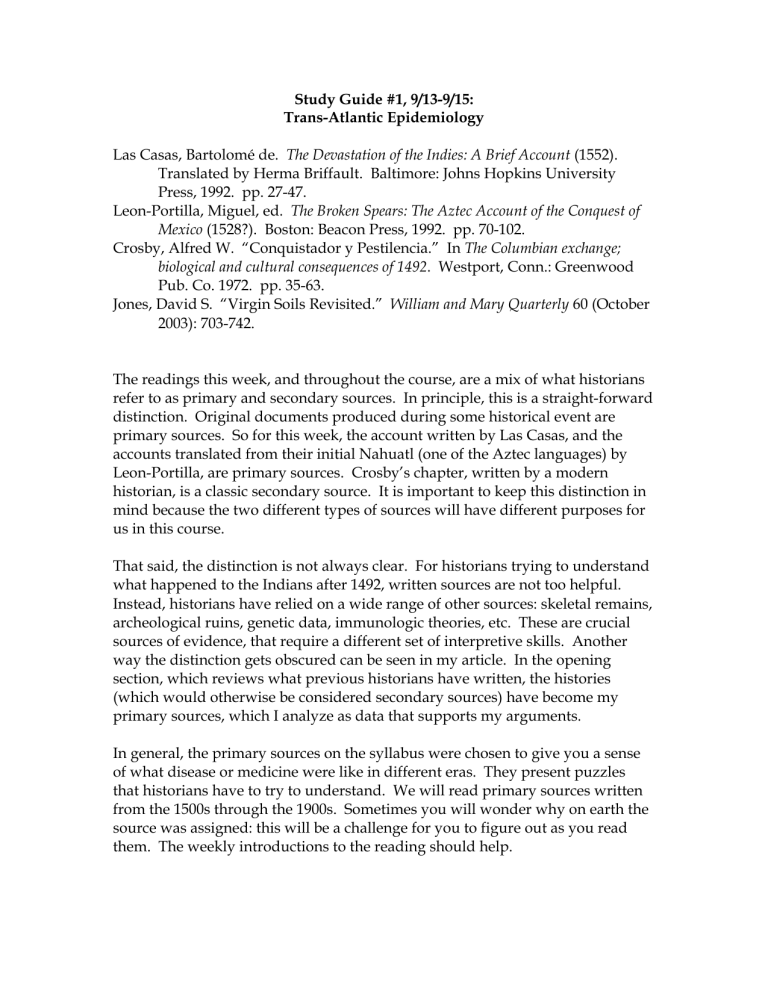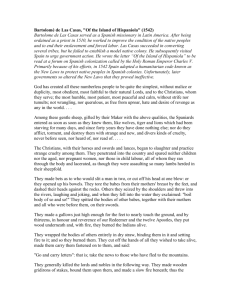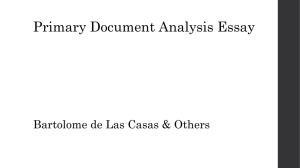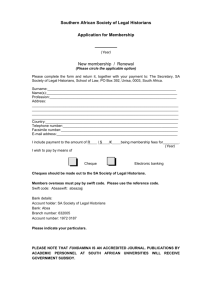Study Guide #1, 9/13-9/15: Trans-Atlantic Epidemiology

Study Guide #1, 9/13-9/15:
Trans-Atlantic Epidemiology
Las Casas, Bartolomé de. The Devastation of the Indies: A Brief Account (1552).
Translated by Herma Briffault. Baltimore: Johns Hopkins University
Press, 1992. pp. 27-47.
Leon-Portilla, Miguel, ed. The Broken Spears: The Aztec Account of the Conquest of
Mexico (1528?). Boston: Beacon Press, 1992. pp. 70-102.
Crosby, Alfred W. “Conquistador y Pestilencia.” In The Columbian exchange; biological and cultural consequences of 1492 . Westport, Conn.: Greenwood
Pub. Co. 1972. pp. 35-63.
Jones, David S. “Virgin Soils Revisited.” William and Mary Quarterly 60 (October
2003): 703-742.
The readings this week, and throughout the course, are a mix of what historians refer to as primary and secondary sources. In principle, this is a straight-forward distinction. Original documents produced during some historical event are primary sources. So for this week, the account written by Las Casas, and the accounts translated from their initial Nahuatl (one of the Aztec languages) by
Leon-Portilla, are primary sources. Crosby’s chapter, written by a modern historian, is a classic secondary source. It is important to keep this distinction in mind because the two different types of sources will have different purposes for us in this course.
That said, the distinction is not always clear. For historians trying to understand what happened to the Indians after 1492, written sources are not too helpful.
Instead, historians have relied on a wide range of other sources: skeletal remains, archeological ruins, genetic data, immunologic theories, etc. These are crucial sources of evidence, that require a different set of interpretive skills. Another way the distinction gets obscured can be seen in my article. In the opening section, which reviews what previous historians have written, the histories
(which would otherwise be considered secondary sources) have become my primary sources, which I analyze as data that supports my arguments.
In general, the primary sources on the syllabus were chosen to give you a sense of what disease or medicine were like in different eras. They present puzzles that historians have to try to understand. We will read primary sources written from the 1500s through the 1900s. Sometimes you will wonder why on earth the source was assigned: this will be a challenge for you to figure out as you read them. The weekly introductions to the reading should help.
Meanwhile, the secondary sources were chosen to give you a sense of 1) what is interesting, exciting, or controversial in the field of history of medicine and disease, and 2) what is it that historians actually do. In the conventional view, historians read primary sources to reconstruct what happened in the past. This is an essential part of history, but it is only a small part. Most historians (even if they won’t admit it) are actually interested in studying and analyzing the past in order to help understand the present, or to inform and guide public policy. As a result, most historians make arguments in their writings: they disagree with what previous historians have said, they introduce new evidence, they try to convince their readers that their new interpretation is correct, and they explain why this is important and relevant to their readers. These aspects of history are clear in Crosby’s chapter and my article.
With this as an introduction, here are a few thoughts about the four readings.
Devastation of the Indies : Bartolomé de Las Casas was the son of a Spanish merchant who traveled to America in 1502. After participating in the conquest, he was put in charge of what was essentially a plantation, with a collection of
Indians working as slaves/serfs. He quickly became disillusioned with Spanish mistreatment of the Indians. In 1511 he became a Dominican priest and dedicated himself to improving conditions for the Indians. He spent the rest of his life traveling back and forth between Spain and the Americas advocating for the Indians. His efforts led to new laws in 1542 that prohibited Indian slavery;
Spanish colonists, however, resisted the laws. Although Las Casas continued his efforts, he was not able to improve conditions substantially. The excerpt on the syllabus is the opening section of his history of the Spanish colonies, in which he documents the long series of abuses by the colonists. Most of the excerpt describes what happened in Hispaniola (now Haiti and the Dominican Republic) and Cuba. Las Casas claims that the population of Hispaniola fell from 3,000,000 in 1492 to 200 in 1551, and that 12,000,000 to 15,000,000 died in the whole
Caribbean basin. He describes deaths (often quite graphically) from murder, disease (p. 28), suicide (p. 46) and overwork (p. 46). What should historians make of all of this? Could his population estimates be reliable? How many people could Spanish colonists have really murdered? Does Las Casas’s lifelong political advocacy on behalf of the Indians undermine his reliability as a reporter of events? Is there such a thing as an unbiased primary source?
Broken Spears : Miguel Leon-Portilla is a professor of indigenous studies in
Mexico, and a scholar of the Nahuatl language (the language spoken by the
Aztecs). In 1959 he studied a series of texts, written in Nahuatl between 1528 and the 1550s, and extracted excerpts that related to the conquest of Mexico by the
Spaniards. Hernan Cortes first entered Tenochtitlan, the Aztec capital, on 8
November 1519, with 600 Spanish troops and a much larger number of Indian
allies. He captured the Montezuma, the Aztec emperor, and briefly controlled the city. The Aztecs counter-attacked, nearly annihilating the Spanish. Cortes and a small remnant survived. However, he was able to regroup, recruit more
Indian allies, and attack again. The city surrendered on 13 August 1521. The excerpts on the syllabus describe a Spanish attack on a Mexican celebration, the ensuing counter-attack and rout of the Spanish, and the start of the eventually successful Spanish siege. Read this with several questions in mind. If this were your only primary source, how would you explain the success of the Spanish conquest? How did the two sides compare in terms of military power and success? Would Aztec and Spanish authors provide different explanations?
What was the role of disease (pp. 92-93) in the Aztec defeat?
“Conquistador y Pestilencia”: Alfred Crosby is an emeritus professor of history at the University of Texas. In the 1970s and 1980s he became a leading expert in biological history, studying the biological consequences of Columbus's discovery in 1492. Prior to Columbus, the flora and fauna of Eurasia and America had been separated for roughly 10,000 years. After Columbus, plants, animals, and diseases from Europe were taken to America, and vice versa. Europe was a huge beneficiary of crops (corn, potatoes, and tomatoes were all native to the Americas
-- imagine Ireland without potatoes, or Italy without tomato sauce). America received domesticated animals (previously only dogs, chickens, llamas, guinea pigs -- no horses, goats, sheep, cows, etc.). But America also received European pathogens. In this chapter he describes the consequences of this disease exchange. For instance, on p. 45 he reassesses Las Casas’s writings; on pp. 48-49 he reviews the conquest of Tenochtitlan. Are biological arguments plausible (e.g. middle paragraph on p. 47, claims about loss of resistance if not exposed to a disease, and assessment of reliability of data from early 1500s); p. 52, claim that
Mexicans lacked immunity)? Other than killing Indians directly, what were the consequences of the epidemics (e.g. pp. 54-58)? Would Las Casas and the
Nahuatl authors agree with Crosby about the role of disease?
“Virgin Soils Revisited”: When I read books by Crosby and other historians, my background in evolutionary biology and infectious disease made me skeptical of virgin soil theory. This article presents my concerns and suggests an alternative explanation. Does my critique of immunological determinism work? What are the holes in my arguments? How would you explain the depopulation of the
Americas? My article also explores why certain kinds of arguments are popular with historians and their audiences, as well as the political and moral consequences of certain kinds of arguments (e.g. my comparison to HIV in the last three paragraphs). Are you convinced?





